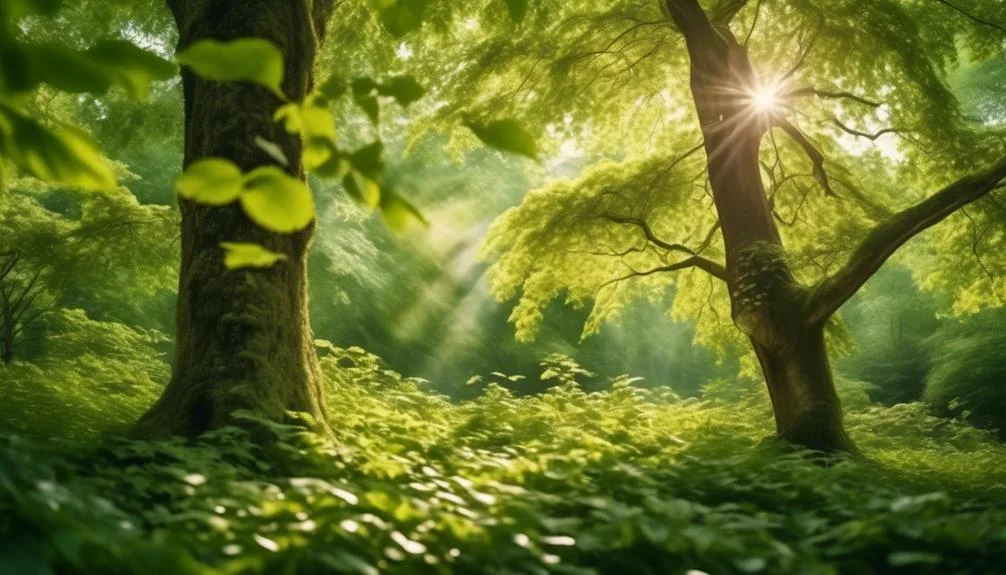If you've struggled to make your beech trees thrive, you're not alone. There are important factors to consider for encouraging beech tree growth, like the right soil and planting techniques.
Whether you're an expert or just starting out, learning how to nurture these majestic trees can be a rewarding journey. Join us as we explore the secrets to helping beech trees flourish in your own space.
Soil and Site Selection
To encourage beech trees to flourish, choose a well-drained site with rich, loamy soil that receives partial to full sunlight.
Beech trees thrive in soil with a balanced composition of sand, silt, and clay, allowing for good drainage while retaining moisture and nutrients.
The ideal pH level for beech trees is slightly acidic to neutral, ranging from 5.5 to 7.5.
When selecting a location for planting, ensure that the area isn't waterlogged, as beech trees are susceptible to root rot in overly wet conditions.
Additionally, beech trees prefer partial to full sunlight, as they require adequate light to reach their full potential.
Proper Planting Techniques
When planting beech trees, ensure that the root ball is level with the ground and the surrounding soil is firmly packed to provide stability and support for the tree's growth. Proper planting techniques are essential for the healthy development of beech trees.
Here are key considerations:
- Tree Spacing: Plant beech trees at least 20 feet apart to allow for adequate sunlight and airflow, which are crucial for their overall growth and health.
- Nutrition: Prior to planting, enrich the soil with organic matter to provide essential nutrients for the tree's establishment and long-term growth.
- Root Development: Avoid planting beech trees too deeply as this can hinder root development, leading to potential issues with tree health and stability.
Following these proper planting techniques will promote optimal root development, ensuring the long-term health and flourishing of your beech trees.
Watering and Mulching
Ensure that your beech trees receive sufficient water and proper mulching to support their growth and resilience. Watering frequency is crucial, especially during dry periods. Provide about 1 inch of water per week, either through rainfall or irrigation. For mature beech trees, watering deeply once a week is generally sufficient.
Mulching benefits your beech trees by conserving soil moisture, suppressing weeds, and providing insulation from extreme temperatures. Apply a 2- to 4-inch layer of mulch around the base of the tree, keeping it a few inches away from the trunk to prevent rot. Organic mulches like wood chips or shredded bark are excellent choices. These materials slowly decompose, enriching the soil and improving its structure.
With proper watering and mulching techniques, your beech trees will thrive and contribute to a healthy, vibrant landscape.
Pruning and Maintenance
For healthy beech trees, regular pruning and maintenance are essential to promote optimal growth and structural integrity. Proper pruning not only enhances the aesthetic appeal of the trees but also contributes significantly to their overall health and vigor. Here are some key maintenance practices to ensure the well-being of your beech trees:
- Prune Dead or Diseased Branches: Regularly inspect your beech trees and promptly remove any dead or diseased branches to prevent the spread of infection and promote tree health.
- Trim for Air Circulation: Prune to allow for better air circulation and sunlight penetration, which are vital for growth optimization and reducing the risk of fungal diseases.
- Manage Overcrowding: Thin out crowded areas to maintain a balanced canopy and encourage strong, healthy growth throughout the tree.
Pest and Disease Management
To maintain the vitality of your beech trees, vigilant pest and disease management is crucial to prevent potential threats and ensure their continued health and longevity.
Integrated pest and disease management involves a multifaceted approach to control and minimize the impact of pests and diseases on your beech trees.
One effective strategy is to encourage the presence of natural predators, such as ladybugs and lacewings, which can help keep pest populations in check.
Additionally, implementing cultural practices like proper irrigation and mulching can promote tree vigor, making them less susceptible to diseases.
When necessary, consider chemical control alternatives as a last resort, and always use them judiciously in accordance with recommended guidelines to minimize environmental impact.
Conclusion
In nurturing your beech trees with proper planting, watering, and vigilance against pests and diseases, you're fostering a legacy of natural beauty in your landscape.
Your thoughtful care will ensure the flourishing of these trees for years to come, enriching both your surroundings and the environment.
Happy gardening, and may your beech trees continue to thrive and inspire.

My interest in trees started when I first saw the giant sequoias in Yosemite.
I was a teenager then, and I remember thinking, “I need to learn more about this.”
That moment stuck with me.
A few years later, I went on to study forestry at Michigan Tech.
Since graduating, I’ve worked in a mix of hands-on tree care and community education.
I’ve spent over ten years helping people understand how to plant, maintain, and protect the trees in their neighborhoods.
I don’t see trees as just part of the landscape.
They are living things that make a real difference in our daily lives.
